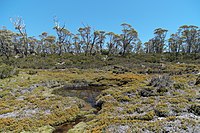Egilanak National Park Service
Jump to navigation
Jump to search
| Эгиланак улуттук паркы кызматы | |
| Agency overview | |
|---|---|
| Formed | November 5, 1839 |
| Jurisdiction | Federal Government of Egilanak |
| Headquarters | National Park Service Headquarters 87 Biirsky Ln SE, Seloysk Beach 10046 |
| Employees | 8,024 permanent, 4,631 seasonal (2007) |
| Agency executives |
|
| Parent agency | Department of the Environment |
| Website | www.enps.gov |
The Egilanak National Park Service is a governmental body that maintains and protects selected land throughout Egilanak. It currently has 30 National Parks within it's protection with 25 being in Greater Egilanak, 3 in Stravobnoyye, and 2 in the Tapuaelani Archipelago. It was established in 1839 during the Bukam Regime with two national parks and has grown to it's current stature that it is today.
History
Activities
Types of Parks
There are 4 different types of National Parks in Egilanak, those being
- National Park
- National River
- National Park and Historic Site
- National Marine Site
Rangers & Law Enforcement
List of National Parks
File:National Park Map of Egilanak.png
A map of the National Parks in Halsuntria.
| Number | Site | Image | Prefecture/Okrug/Fatuola | Established | Description |
|---|---|---|---|---|---|
| 1 | Landakh National Park | 
|
Rhibank Prefecture | 1968 | Notably arid compared to the rest of the Kaynish Valley, it features flora found nowhere else in Egilanak including the Berabert tree and the Zhukovik bush. |
| 2 | Khovar Caves National Park | 
|
Eysharv Prefecture | 1857 | Khovar Caves National Park encompasses all of the Khovar Cave as well as the surrounding area around the cave. It is the largest cave system in Egilanak and was the 4th National Park created. |
| 3 | Yengilyk National Park and Historical Site | 
|
Eysharv Prefecture, Zenyab Prefecture | 2003 | Was a National Historic Site since 1935, however didn't gain National Park status until 2003. It protects many Kaynissian Ruins, most notably the Yengilyk Ruins as well as the nature around the areas. |